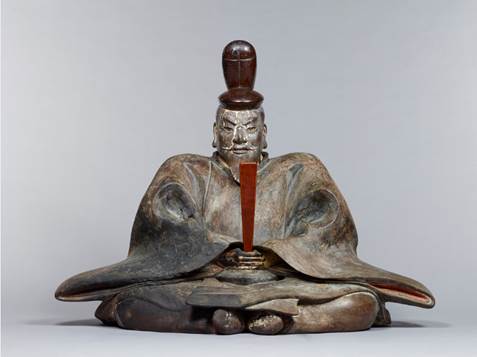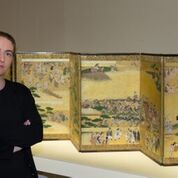

Growing up in Northeast Ohio, especially near Cleveland, you became aware very early on that the Cleveland Museum of Art (CMA) housed one of the best Asian Art collections in the world. Whenever Paul went on junior high field trips to CMA, he made a beeline for the sculptures, the detailed masks, and of course the unique and beautifully-painted screens showing true Japanese life centuries ago. Paola, weekly left to her own devices in the Armor Court, would take a break from reading to the horse or perusing at the El Greco and the weapons, and head off to look at the jade figurines and jewelry and the amazingly intricate woodwork artifacts.

Boxes for the Kasuga Dragon Jewels: Outer Box, 1300s. Nanbokuchō period (1336–92). Lacquered wood with color; 43.3 x 52 x 44.7 cm. Nara National Museum. Important Cultural Property. Photo: Nara National Museum
CMA now brings to the public Shinto: Discovery of the Divine in Japanese Art, and we encourage anyone in or around the Cleveland area to hurry and see this wonderful exhibition before it ends June 30th. Even if you’ve seen it already, there’s now a new rotation of items not seen before – new sculptures and paintings, and if you were at all curious what was inside that large ornamental box towards the end of the tour, it has now been opened so you can peek inside. What will you see? You’ll have to visit CMA to find out!


Asian art represents many countries, religions, cultures and even influences of invaders. Sinéad Vilbar is the curator of Japanese art responsible for the research and presentation of the museum’s world-renowned collection of Japanese art, as well as acquisitions to further enhance the museum’s collection. For this exclusive exhibition, Ms. Vilbar has drawn on CMA’s vast Asian art collection, as well as borrowed pieces from other collections – from Japanese museums, private collections and other collections in the United States – to create an incomparable experience celebrating Shinto Art. The special cooperation of the Nara National Museum located in Nara, Japan, (which boasts a rich history itself that goes back to the 700s, when it was the capital of the country), made this major international loan exhibition exclusive to Cleveland possible.

Seated Tenjin, 1261. Kamakura period (1185–1333). Wood with pigments; h. 83.5 cm. Egara Tenjinsha, Kamakura, Kanagawa Prefecture. Important Cultural Property. Photo: Nara National Museum
Shinto or “way of the gods” is the indigenous religion of Japan. It is one of the oldest continuously practiced religions in the world, with its origins lost in history. Shinto is primarily a nature-based religion, with its deities or kami embedded in trees, rocks, mountains, and waterfalls, to name a few. Prior to the influence of Buddhism, there were few anthropomorphic representations of the kami, and were merely sacred spiritual spots. Buddhist art, (and Confucianism’s ancestor worship) influenced Shinto so that artists began to depict their kami as recognizable beings and not merely spirits. Japanese mythology teaches that the kami were responsible for creating Japan and then ascended to heaven to rule, only occasionally visiting to inhabit all things natural, and like nature herself, can be benevolent or volatile.

Kasuga Mandala Reliquary Shrine, 1479. Muromachi period (1392–1573). Lacquered wood with color; 55.6 x 39.7 x 48 cm. Tokyo National Museum. Photo: TNM Image Archives
The miniature shrine above, said to be an architectural representation of Takemikazuchi, the kami of the first shrine at Kasuga Taisha, was meant to contain relics of the historical Buddha Shakyamuni, Takemikazuchi’s Buddhist counterpart. On the front doors are Aizen Myōō, the wisdom king of passion (right), and Fudō Myōō, wisdom king of immovability (left). The side doors show the guardian kings of the four directions. The back wall inside the shrine vividly portrays a view of the landscape of Kasuga Taisha. Based on other examples, we can assume that a gem-shaped reliquary would once have been installed in the center.

When we entered the first rotation of the exhibition (we plan to go back to see more, of course!) we were presented with a historical perspective of the kami and their dispositions. They have likes and dislikes, much as their worshippers do, and many of the large painted or chalked screens show sporting events or Noh theater performances. The screens are massive and exquisitely depict the life and interactions of the kami with their followers.
From Noh theater make-up boxes and costumes, to statues and masks of the various kami, the exhibition presents the divine mixed with the earthly. Kami and humans mix together in games, theater, and depictions of divine interactions. Each work tells the story of the Japanese and their close personal relationships with their gods.
Some of the 125 works of art (many never seen outside Japan until now) are being rotated as they are particularly fragile and may only be on display a few weeks each year to maintain their structural integrity. (There is a checklist available on the CMA Site)The 20 objects designated as “Important Cultural Properties” by the Japanese Government are the ones with the most stringent display requirements. If you missed the first rotation, there will be more to see in the second. On the other hand, if you can go twice, please do so, as the new additions will be as fantastic as the ones rotated out.
As summer draws near, it’s great to get out more, but one of your first trips alone, with friends, or with your family, should be the Cleveland Museum of Art to witness some astounding depictions of Japanese history. It’s a terrific opportunity to learn about an ancient religion and get closer and more personal with the kami.
About the Cleveland Museum of Art
The Cleveland Museum of Art is renowned for the quality and breadth of its collection, which includes more than 61,000 objects and spans 6,000 years of achievement in the arts. The museum is a significant international forum for exhibitions, scholarship and performing arts. One of the top comprehensive art museums in the nation and free of charge to all, the Cleveland Museum of Art is located in the dynamic University Circle neighborhood.
The Cleveland Museum of Art receives funding from a broad range of individuals, foundations, and businesses in Cleveland and northeast Ohio. The museum is supported in part by residents of Cuyahoga County through a public grant from Cuyahoga Arts & Culture and made possible in part by state tax dollars allocated by the Ohio Legislature to the Ohio Arts Council (OAC). The OAC is a state agency that funds and supports quality arts experiences to strengthen Ohio communities culturally, educationally, and economically. For more information about the museum and its holdings, programs and events, call 888-CMA-0033 or visit ClevelandArt.org

